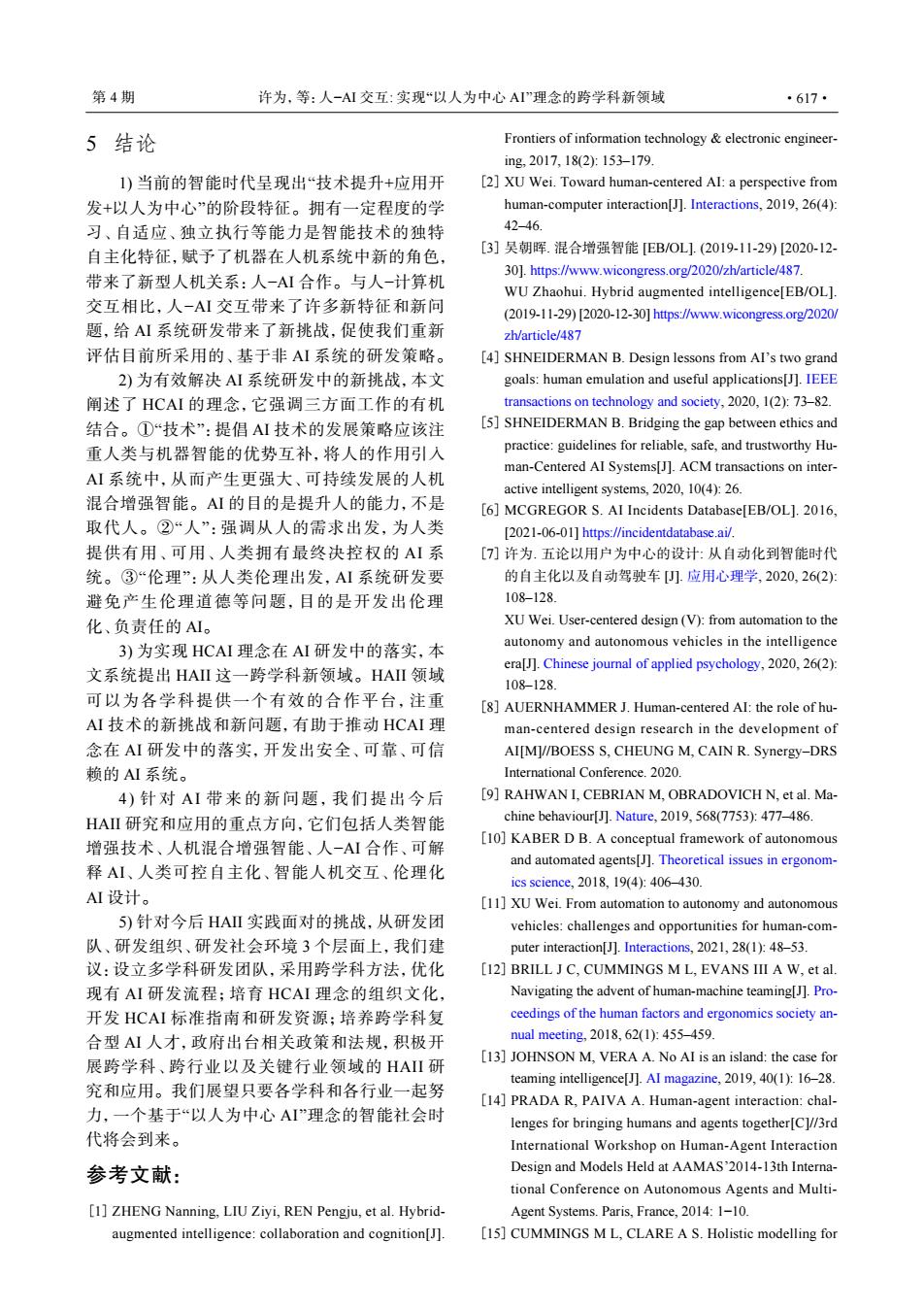正在加载图片...

第4期 许为,等:人-A交互:实现“以人为中心AI”理念的跨学科新领域 ·617· 5结论 Frontiers of information technology electronic engineer ing,2017,18(2:153-179. 1)当前的智能时代呈现出“技术提升+应用开 [2]XU Wei.Toward human-centered AI:a perspective from 发+以人为中心”的阶段特征。拥有一定程度的学 human-computer interaction[J].Interactions,2019,26(4): 习、自适应、独立执行等能力是智能技术的独特 42-46 自主化特征,赋予了机器在人机系统中新的角色, [3]吴朝晖.混合增强智能[EB/OL.(2019-11-29)[2020-12- 带来了新型人机关系:人-AI合作。与人-计算机 30].https://www.wicongress.org/2020/zh/article/487. WU Zhaohui.Hybrid augmented intelligence[EB/OL]. 交互相比,人-AI交互带来了许多新特征和新问 (2019-11-29)[2020-12-30]htps/www.wicongress.org/2020/ 题,给AI系统研发带来了新挑战,促使我们重新 zh/article/487 评估目前所采用的、基于非AI系统的研发策略。 [4]SHNEIDERMAN B.Design lessons from AI's two grand 2)为有效解决A系统研发中的新挑战,本文 goals:human emulation and useful applications[J].IEEE 阐述了HCAI的理念,它强调三方面工作的有机 transactions on technology and society,2020,1(2):73-82 结合。①“技术”:提倡AI技术的发展策略应该注 [5]SHNEIDERMAN B.Bridging the gap between ethics and 重人类与机器智能的优势互补,将人的作用引入 practice:guidelines for reliable,safe,and trustworthy Hu- AI系统中,从而产生更强大、可持续发展的人机 man-Centered AI Systems[J].ACM transactions on inter- active intelligent systems,2020,10(4):26 混合增强智能。AI的目的是提升人的能力,不是 [6]MCGREGOR S.AI Incidents Database[EB/OL].2016, 取代人。②“人”:强调从人的需求出发,为人类 [2021-06-01]https://incidentdatabase.ai/. 提供有用、可用、人类拥有最终决控权的AI系 [7]许为.五论以用户为中心的设计:从自动化到智能时代 统。③“伦理”:从人类伦理出发,AI系统研发要 的自主化以及自动驾驶车).应用心理学,2020,26(2): 避免产生伦理道德等问题,目的是开发出伦理 108-128 化、负责任的AI。 XU Wei.User-centered design(V):from automation to the 3)为实现HCAI理念在AI研发中的落实,本 autonomy and autonomous vehicles in the intelligence era[J].Chinese journal of applied psychology,2020,26(2): 文系统提出HAⅡ这一跨学科新领域。HAⅡ领域 108-128 可以为各学科提供一个有效的合作平台,注重 [8]AUERNHAMMER J.Human-centered AI:the role of hu- AI技术的新挑战和新问题,有助于推动HCAI理 man-centered design research in the development of 念在AI研发中的落实,开发出安全、可靠、可信 AI[M]//BOESS S,CHEUNG M,CAIN R.Synergy-DRS 赖的AI系统。 International Conference.2020. 4)针对AI带来的新问题,我们提出今后 [9]RAHWAN I,CEBRIAN M,OBRADOVICH N,et al.Ma- HAⅡ研究和应用的重点方向,它们包括人类智能 chine behaviour[J].Nature,2019,568(7753):477-486. 增强技术、人机混合增强智能、人-AI合作、可解 [10]KABER D B.A conceptual framework of autonomous and automated agents[J].Theoretical issues in ergonom- 释AI、人类可控自主化、智能人机交互、伦理化 ics science,.2018,19(4):406-430. AI设计。 [11]XU Wei.From automation to autonomy and autonomous 5)针对今后HAⅡ实践面对的挑战,从研发团 vehicles:challenges and opportunities for human-com- 队、研发组织、研发社会环境3个层面上,我们建 puter interaction[J].Interactions,2021,28(1):48-53 议:设立多学科研发团队,采用跨学科方法,优化 [12]BRILL J C,CUMMINGS ML,EVANS III A W,et al. 现有AI研发流程;培育HCAI理念的组织文化, Navigating the advent of human-machine teaming[J].Pro- 开发HCAI标准指南和研发资源;培养跨学科复 ceedings of the human factors and ergonomics society an- 合型AI人才,政府出台相关政策和法规,积极开 nual meeting,.2018,62(1)455-459. 展跨学科、跨行业以及关键行业领域的HAI研 [13]JOHNSON M,VERA A.No AI is an island:the case for teaming intelligence[J].AI magazine,2019,40(1):16-28. 究和应用。我们展望只要各学科和各行业一起努 [14]PRADA R.PAIVA A.Human-agent interaction:chal- 力,一个基于“以人为中心AI”理念的智能社会时 lenges for bringing humans and agents together[C]//3rd 代将会到来。 International Workshop on Human-Agent Interaction 参考文献: Design and Models Held at AAMAS'2014-13th Interna- tional Conference on Autonomous Agents and Multi- [1]ZHENG Nanning,LIU Ziyi,REN Pengju,et al.Hybrid- Agent Systems.Paris,France,2014:1-10. augmented intelligence:collaboration and cognition[J]. [15]CUMMINGS ML,CLARE A S.Holistic modelling for5 结论 1) 当前的智能时代呈现出“技术提升+应用开 发+以人为中心”的阶段特征。拥有一定程度的学 习、自适应、独立执行等能力是智能技术的独特 自主化特征,赋予了机器在人机系统中新的角色, 带来了新型人机关系:人−AI 合作。与人−计算机 交互相比,人−AI 交互带来了许多新特征和新问 题,给 AI 系统研发带来了新挑战,促使我们重新 评估目前所采用的、基于非 AI 系统的研发策略。 2) 为有效解决 AI 系统研发中的新挑战,本文 阐述了 HCAI 的理念,它强调三方面工作的有机 结合。①“技术”:提倡 AI 技术的发展策略应该注 重人类与机器智能的优势互补,将人的作用引入 AI 系统中,从而产生更强大、可持续发展的人机 混合增强智能。AI 的目的是提升人的能力,不是 取代人。②“人”:强调从人的需求出发,为人类 提供有用、可用、人类拥有最终决控权的 AI 系 统。③“伦理”:从人类伦理出发,AI 系统研发要 避免产生伦理道德等问题,目的是开发出伦理 化、负责任的 AI。 3) 为实现 HCAI 理念在 AI 研发中的落实,本 文系统提出 HAII 这一跨学科新领域。HAII 领域 可以为各学科提供一个有效的合作平台,注重 AI 技术的新挑战和新问题,有助于推动 HCAI 理 念在 AI 研发中的落实,开发出安全、可靠、可信 赖的 AI 系统。 4) 针对 AI 带来的新问题,我们提出今后 HAII 研究和应用的重点方向,它们包括人类智能 增强技术、人机混合增强智能、人−AI 合作、可解 释 AI、人类可控自主化、智能人机交互、伦理化 AI 设计。 5) 针对今后 HAII 实践面对的挑战,从研发团 队、研发组织、研发社会环境 3 个层面上,我们建 议:设立多学科研发团队,采用跨学科方法,优化 现有 AI 研发流程;培育 HCAI 理念的组织文化, 开发 HCAI 标准指南和研发资源;培养跨学科复 合型 AI 人才,政府出台相关政策和法规,积极开 展跨学科、跨行业以及关键行业领域的 HAII 研 究和应用。我们展望只要各学科和各行业一起努 力,一个基于“以人为中心 AI”理念的智能社会时 代将会到来。 参考文献: ZHENG Nanning, LIU Ziyi, REN Pengju, et al. Hybridaugmented intelligence: collaboration and cognition[J]. [1] Frontiers of information technology & electronic engineering, 2017, 18(2): 153–179. XU Wei. Toward human-centered AI: a perspective from human-computer interaction[J]. Interactions, 2019, 26(4): 42–46. [2] 吴朝晖. 混合增强智能 [EB/OL]. (2019-11-29) [2020-12- 30]. https://www.wicongress.org/2020/zh/article/487. WU Zhaohui. Hybrid augmented intelligence[EB/OL]. (2019-11-29) [2020-12-30] https://www.wicongress.org/2020/ zh/article/487 [3] SHNEIDERMAN B. Design lessons from AI’s two grand goals: human emulation and useful applications[J]. IEEE transactions on technology and society, 2020, 1(2): 73–82. [4] SHNEIDERMAN B. Bridging the gap between ethics and practice: guidelines for reliable, safe, and trustworthy Human-Centered AI Systems[J]. ACM transactions on interactive intelligent systems, 2020, 10(4): 26. [5] MCGREGOR S. AI Incidents Database[EB/OL]. 2016, [2021-06-01] https://incidentdatabase.ai/. [6] 许为. 五论以用户为中心的设计: 从自动化到智能时代 的自主化以及自动驾驶车 [J]. 应用心理学, 2020, 26(2): 108–128. XU Wei. User-centered design (V): from automation to the autonomy and autonomous vehicles in the intelligence era[J]. Chinese journal of applied psychology, 2020, 26(2): 108–128. [7] AUERNHAMMER J. Human-centered AI: the role of human-centered design research in the development of AI[M]//BOESS S, CHEUNG M, CAIN R. Synergy–DRS International Conference. 2020. [8] RAHWAN I, CEBRIAN M, OBRADOVICH N, et al. Machine behaviour[J]. Nature, 2019, 568(7753): 477–486. [9] KABER D B. A conceptual framework of autonomous and automated agents[J]. Theoretical issues in ergonomics science, 2018, 19(4): 406–430. [10] XU Wei. From automation to autonomy and autonomous vehicles: challenges and opportunities for human-computer interaction[J]. Interactions, 2021, 28(1): 48–53. [11] BRILL J C, CUMMINGS M L, EVANS III A W, et al. Navigating the advent of human-machine teaming[J]. Proceedings of the human factors and ergonomics society annual meeting, 2018, 62(1): 455–459. [12] JOHNSON M, VERA A. No AI is an island: the case for teaming intelligence[J]. AI magazine, 2019, 40(1): 16–28. [13] PRADA R, PAIVA A. Human-agent interaction: challenges for bringing humans and agents together[C]//3rd International Workshop on Human-Agent Interaction Design and Models Held at AAMAS’2014-13th International Conference on Autonomous Agents and MultiAgent Systems. Paris, France, 2014: 1−10. [14] [15] CUMMINGS M L, CLARE A S. Holistic modelling for 第 4 期 许为,等:人−AI 交互: 实现“以人为中心 AI”理念的跨学科新领域 ·617·